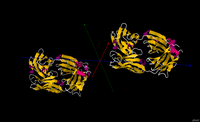
Photo from wikipedia
Cetuximab administration is contingent upon the upfront determination of Ras mutational status, because mutated patients are unlikely to respond to this therapy. In addition to tumor genomics, drug exposure levels… Click to show full abstract
Cetuximab administration is contingent upon the upfront determination of Ras mutational status, because mutated patients are unlikely to respond to this therapy. In addition to tumor genomics, drug exposure levels could be a critical yet largely underestimated issue, because several reports have already demonstrated that cetuximab pharmacokinetic parameters (i.e., clearance values) could be associated with survival in patients. Here, we have developed an original bioanalytical method based upon the use of LC-MS/MS technology and a highly simplified sample preparation procedure to assay cetuximab in patients while meeting the requirements of standard therapeutic drug monitoring in routine clinical practice. We used this method prospectively to evaluate the inter-patient variability in drug exposure, and to search whether those exposure levels could be associated with clinical endpoints. A total of 25 adult patients (22 M, 3F, mean age: 69 years) hospitalized for head and neck cancer and scheduled for a cetuximab-containing regimen (250 mg/m² QW) were included to perform this pilot study. Seven patients received concomitant radiotherapy and 14 patients received concomitant chemotherapy. 28% of patients displayed severe toxicities (CTC grading). Following RECIST assessment, 10 out of 25 patients (40%) had progressive disease and 60% were categorized as patients with clinical benefit (stable disease: 5 patients (20%), partial response: 7 patients (28%), complete response: 3 patients (12%)). A large inter-patient variability was observed among individuals. Mean cetuximab residual concentrations were 40.3 ± 20.3 µg/ml (CV: 51%, range 0-74.6 µg/ml) and mean cetuximab maximal concentrations were 126.9 ± 39.6 µg/ml (CV: 31%, range 65.1-210.6 µg/ml). No statistical difference was observed in cetuximab residual concentrations between patients with and without severe toxicities (36.7 ± 21.2 µg/ml VS. 41.8 ± 20 µg/ml, p>0.05, t test), nor in maximal cetuximab concentrations (117.1 ± 31.3 µg/ml VS. 130.3 ± 39.70 µg/ml, p>0.05, t test). Conversely, when comparing exposure levels in patients with clinical benefit to non-responding patients, a statistical difference was found in both cetuximab residual concentrations (49 ± 16.3 µg/ml VS. 25.8 ± 17 µg/ml, p Citation Format: Joseph Ciccolini, Francois Becher, Diane-Charlotte Imbs, Claire Fournel, Florence Duffaud, Bruno Lacarelle, Sebastien Salas. Residual concentrations of cetuximab predict clinical response in head and neck cancer patients [abstract]. In: Proceedings of the American Association for Cancer Research Annual Meeting 2017; 2017 Apr 1-5; Washington, DC. Philadelphia (PA): AACR; Cancer Res 2017;77(13 Suppl):Abstract nr 5048. doi:10.1158/1538-7445.AM2017-5048
Journal Title: Cancer Research
Year Published: 2017
Link to full text (if available)
Share on Social Media: Sign Up to like & get
recommendations!